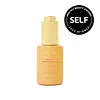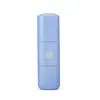What's inside
What's inside
 Key Ingredients
Key Ingredients

 Benefits
Benefits

 Concerns
Concerns

 Ingredients Side-by-side
Ingredients Side-by-side

Water
Skin ConditioningGlycerin
HumectantButylene Glycol
HumectantSodium Ascorbyl Phosphate
AntioxidantPEG-8
HumectantPropanediol
Solvent3-O-Ethyl Ascorbic Acid
Skin ConditioningNonapeptide-1
Skin ConditioningPsidium Guajava Leaf Extract
AstringentTetrahexyldecyl Ascorbate
AntioxidantAloe Barbadensis Leaf Juice
Skin ConditioningPsidium Guajava Fruit Extract
AstringentVitis Vinifera Fruit Extract
Skin ConditioningGlycereth-7 Triacetate
EmollientDipropylene Glycol
HumectantPhenoxyethanol
PreservativePEG-40 Hydrogenated Castor Oil
EmulsifyingPPG-26-Buteth-26
Skin ConditioningParfum
MaskingEthylhexylglycerin
Skin ConditioningHydroxyethyl Acrylate/Sodium Acryloyldimethyl Taurate Copolymer
Emulsion StabilisingSodium Benzotriazolyl Butylphenol Sulfonate
UV AbsorberTetrasodium Glutamate Diacetate
Cellulose Gum
Emulsion StabilisingXanthan Gum
EmulsifyingTriticum Vulgare Sprout Extract
Skin ConditioningHydroxymethoxyphenyl Decanone
Skin ConditioningSodium Hyaluronate
HumectantSorbitol
HumectantPolysorbate 60
EmulsifyingSorbitan Isostearate
EmulsifyingSodium Phosphate
BufferingTocopheryl Acetate
AntioxidantCaprylyl Glycol
EmollientSaccharomyces Lysate Extract
HumectantPotassium Sorbate
PreservativeSodium Benzoate
MaskingDisodium Phosphate
BufferingLimonene
PerfumingHexyl Cinnamal
PerfumingCitral
PerfumingLinalool
PerfumingCI 15985
Cosmetic ColorantCI 16035
Cosmetic ColorantWater, Glycerin, Butylene Glycol, Sodium Ascorbyl Phosphate, PEG-8, Propanediol, 3-O-Ethyl Ascorbic Acid, Nonapeptide-1, Psidium Guajava Leaf Extract, Tetrahexyldecyl Ascorbate, Aloe Barbadensis Leaf Juice, Psidium Guajava Fruit Extract, Vitis Vinifera Fruit Extract, Glycereth-7 Triacetate, Dipropylene Glycol, Phenoxyethanol, PEG-40 Hydrogenated Castor Oil, PPG-26-Buteth-26, Parfum, Ethylhexylglycerin, Hydroxyethyl Acrylate/Sodium Acryloyldimethyl Taurate Copolymer, Sodium Benzotriazolyl Butylphenol Sulfonate, Tetrasodium Glutamate Diacetate, Cellulose Gum, Xanthan Gum, Triticum Vulgare Sprout Extract, Hydroxymethoxyphenyl Decanone, Sodium Hyaluronate, Sorbitol, Polysorbate 60, Sorbitan Isostearate, Sodium Phosphate, Tocopheryl Acetate, Caprylyl Glycol, Saccharomyces Lysate Extract, Potassium Sorbate, Sodium Benzoate, Disodium Phosphate, Limonene, Hexyl Cinnamal, Citral, Linalool, CI 15985, CI 16035
Camellia Sinensis Leaf
PerfumingGlycerin
HumectantPropanediol
SolventWater
Skin ConditioningSqualane
EmollientGlyceryl Stearate
EmollientIsononyl Isononanoate
EmollientBehenyl Alcohol
EmollientDimethicone
EmollientStearyl Alcohol
EmollientSodium Hyaluronate
HumectantHydrolyzed Collagen
EmollientHydrolyzed Elastin
EmollientBetaphycus Gelatinum Extract
BleachingCrambe Abyssinica Seed Oil
Skin ConditioningStearyl Glycyrrhetinate
Skin ConditioningAscorbyl Tetraisopalmitate
AntioxidantPhytosteryl Macadamiate
Skin ConditioningTocopheryl Acetate
AntioxidantSodium Dilauramidoglutamide Lysine
HumectantSodium Chondroitin Sulfate
Skin ConditioningPolyglyceryl-10 Eicosanedioate/Tetradecanedioate
Skin ConditioningCellulose Gum
Emulsion StabilisingHydroxyethyl Acrylate/Sodium Acryloyldimethyl Taurate Copolymer
Emulsion StabilisingDisodium Phosphate
BufferingPotassium Phosphate
BufferingDisodium EDTA
Ethylhexylglycerin
Skin ConditioningSorbitan Isostearate
EmulsifyingPolysorbate 60
EmulsifyingButylene Glycol
HumectantTocopherol
AntioxidantAlcohol
AntimicrobialParfum
MaskingPhenoxyethanol
PreservativeCamellia Sinensis Leaf, Glycerin, Propanediol, Water, Squalane, Glyceryl Stearate, Isononyl Isononanoate, Behenyl Alcohol, Dimethicone, Stearyl Alcohol, Sodium Hyaluronate, Hydrolyzed Collagen, Hydrolyzed Elastin, Betaphycus Gelatinum Extract, Crambe Abyssinica Seed Oil, Stearyl Glycyrrhetinate, Ascorbyl Tetraisopalmitate, Phytosteryl Macadamiate, Tocopheryl Acetate, Sodium Dilauramidoglutamide Lysine, Sodium Chondroitin Sulfate, Polyglyceryl-10 Eicosanedioate/Tetradecanedioate, Cellulose Gum, Hydroxyethyl Acrylate/Sodium Acryloyldimethyl Taurate Copolymer, Disodium Phosphate, Potassium Phosphate, Disodium EDTA, Ethylhexylglycerin, Sorbitan Isostearate, Polysorbate 60, Butylene Glycol, Tocopherol, Alcohol, Parfum, Phenoxyethanol
Ingredients Explained
These ingredients are found in both products.
Ingredients higher up in an ingredient list are typically present in a larger amount.
Butylene Glycol (or BG) is used within cosmetic products for a few different reasons:
Overall, Butylene Glycol is a safe and well-rounded ingredient that works well with other ingredients.
Though this ingredient works well with most skin types, some people with sensitive skin may experience a reaction such as allergic rashes, closed comedones, or itchiness.
Learn more about Butylene GlycolCellulose Gum is a water-soluble polymer that comes from cellulose. It is used to change the texture of a product and to help stabilize emulsions.
As an emulsifier, cellulose gum specifically thicken the texture of water-based products.
This ingredient is considered hypoallergenic and non-toxic. Cellulose Gum can be found in cosmetics, food, and other household goods such as paper products.
Learn more about Cellulose GumDisodium Phosphate is a water-soluble powder used as a pH adjuster.
Ethylhexylglycerin (we can't pronounce this either) is commonly used as a preservative and skin softener. It is derived from glyceryl.
You might see Ethylhexylglycerin often paired with other preservatives such as phenoxyethanol. Ethylhexylglycerin has been found to increase the effectiveness of these other preservatives.
Glycerin is already naturally found in your skin. It helps moisturize and protect your skin.
A study from 2016 found glycerin to be more effective as a humectant than AHAs and hyaluronic acid.
As a humectant, it helps the skin stay hydrated by pulling moisture to your skin. The low molecular weight of glycerin allows it to pull moisture into the deeper layers of your skin.
Hydrated skin improves your skin barrier; Your skin barrier helps protect against irritants and bacteria.
Glycerin has also been found to have antimicrobial and antiviral properties. Due to these properties, glycerin is often used in wound and burn treatments.
In cosmetics, glycerin is usually derived from plants such as soybean or palm. However, it can also be sourced from animals, such as tallow or animal fat.
This ingredient is organic, colorless, odorless, and non-toxic.
Glycerin is the name for this ingredient in American English. British English uses Glycerol/Glycerine.
Learn more about GlycerinThis is a synthetic polymer. It helps improve the texture of products by adding thickness and gel-like feel.
It is also an emulsifer, meaning it prevents ingredients such as oil and water from separating. It also helps evenly disperse other ingredients.
Parfum is a catch-all term for an ingredient or more that is used to give a scent to products.
Also called "fragrance", this ingredient can be a blend of hundreds of chemicals or plant oils. This means every product with "fragrance" or "parfum" in the ingredients list is a different mixture.
For instance, Habanolide is a proprietary trade name for a specific aroma chemical. When used as a fragrance ingredient in cosmetics, most aroma chemicals fall under the broad labeling category of “FRAGRANCE” or “PARFUM” according to EU and US regulations.
The term 'parfum' or 'fragrance' is not regulated in many countries. In many cases, it is up to the brand to define this term.
For instance, many brands choose to label themselves as "fragrance-free" because they are not using synthetic fragrances. However, their products may still contain ingredients such as essential oils that are considered a fragrance by INCI standards.
One example is Calendula flower extract. Calendula is an essential oil that still imparts a scent or 'fragrance'.
Depending on the blend, the ingredients in the mixture can cause allergies and sensitivities on the skin. Some ingredients that are known EU allergens include linalool and citronellol.
Parfum can also be used to mask or cover an unpleasant scent.
The bottom line is: not all fragrances/parfum/ingredients are created equally. If you are worried about fragrances, we recommend taking a closer look at an ingredient. And of course, we always recommend speaking with a professional.
Learn more about ParfumPhenoxyethanol is a preservative that has germicide, antimicrobial, and aromatic properties. Studies show that phenoxyethanol can prevent microbial growth. By itself, it has a scent that is similar to that of a rose.
It's often used in formulations along with Caprylyl Glycol to preserve the shelf life of products.
Polysorbate 60 is used to help stabilize products. It is a surfactant and emulsifier. These properties help keep ingredients together in a product. Surfactants help reduce surface tension between ingredients with different states, such as liquids and solids. Emulsifiers help prevent oils and waters from separating.
Polysorbate 60 is sorbitol-based and created from the ethoxylation of sorbitan. Ethoxylation is a chemical reaction used to add ethylene oxide. Sorbitan is a the dehydrated version of sorbitol, a sugar found in fruits.
In this case, the 60 comes from reacting 60 units of ethylene oxide with sorbitan.
Polysorbates are commonly used in medicine and foods.
Learn more about Polysorbate 60Propanediol is an all-star ingredient. It softens, hydrates, and smooths the skin.
It’s often used to:
Propanediol is not likely to cause sensitivity and considered safe to use. It is derived from corn or petroleum with a clear color and no scent.
Learn more about PropanediolSodium Hyaluronate is hyaluronic acid's salt form. It is commonly derived from the sodium salt of hyaluronic acid.
Like hyaluronic acid, it is great at holding water and acts as a humectant. This makes it a great skin hydrating ingredient.
Sodium Hyaluronate is naturally occurring in our bodies and is mostly found in eye fluid and joints.
These are some other common types of Hyaluronic Acid:
Learn more about Sodium HyaluronateSorbitan Isostearate is an emulsifer and cleaning agent. It is created from isostearic acid and sorbitol.
As an emulsifier, Sorbitan Isostearate prevents oils and water from separating.
Due to its isostearic acid base, it may not be safe for Malassezia or fungal acne.
Learn more about Sorbitan IsostearateTocopheryl Acetate is AKA Vitamin E. It is an antioxidant and protects your skin from free radicals. Free radicals damage the skin by breaking down collagen.
One study found using Tocopheryl Acetate with Vitamin C decreased the number of sunburned cells.
Tocopheryl Acetate is commonly found in both skincare and dietary supplements.
Learn more about Tocopheryl AcetateWater. It's the most common cosmetic ingredient of all. You'll usually see it at the top of ingredient lists, meaning that it makes up the largest part of the product.
So why is it so popular? Water most often acts as a solvent - this means that it helps dissolve other ingredients into the formulation.
You'll also recognize water as that liquid we all need to stay alive. If you see this, drink a glass of water. Stay hydrated!
Learn more about Water